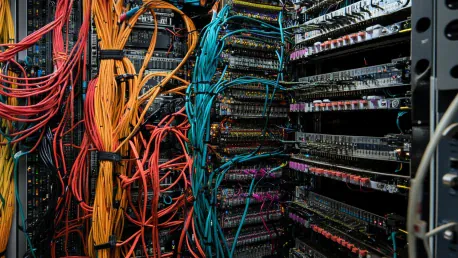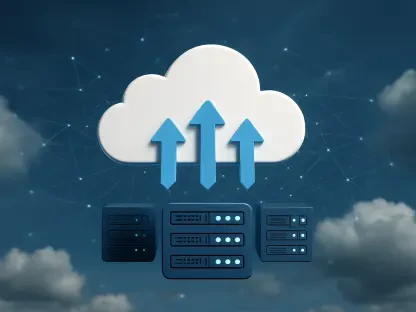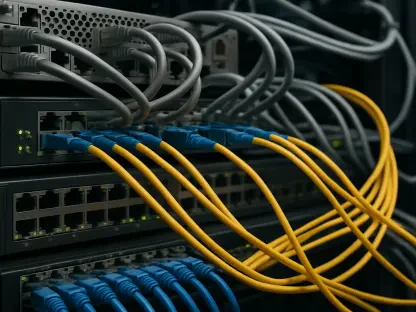Data centers play a crucial role in modern IT infrastructure, delivering essential services to users across various industries. As demands for faster and more robust connectivity continue to surge, data centers are increasingly adopting advanced networking technologies to efficiently manage and optimize the storage and processing of applications and data. With the data center networking market valued at $21.43 billion in 2022 and rapidly expanding, especially in North America due to the widespread deployment of 5G technology, understanding the key networking technologies that support these operations is paramount.
Switching Technology
Switching technology forms the backbone of data center operations, enabling high-performance data transfer between devices within a network. Through the use of advanced switches, data packets are seamlessly transferred among servers, storage devices, and other network hardware. This smooth communication and data sharing among various components are fundamental to large-scale data processing and virtualization. As data centers become larger and more complex, the need for efficient data flow across the infrastructure becomes even more critical to ensure smooth and effective operations.
These switches are indispensable in maintaining the performance and reliability of data centers by managing vast amounts of data that need to be processed and stored. By accurately and quickly transferring information between devices, they help prevent bottlenecks and ensure that data center operations run swiftly and without interruptions. The role of robust switching technology becomes particularly significant as data centers grow in size and demand higher levels of efficiency and reliability, underscoring the criticality of these advanced switches in modern data centers.
Routing
Routing is the process of directing data packets from one location to another within a network based on a set of predetermined rules to minimize delays and maximize efficiency. In the context of data centers with thousands of nodes, routing is crucial in maintaining optimal network performance and reducing latency. This importance is heightened by the frequent hardware and software failures or congestion that can arise in such extensive networks.
Efficient routing ensures that data packets reach their intended destination swiftly and reliably, which is vital for sustaining the overall performance and reliability of data center operations. By selecting the most favorable paths for data transmission, routing plays a significant role in preventing bottlenecks and mitigating the risk of data loss or corruption. This level of efficiency and reliability in data packet transmission is essential to the smooth functioning of data centers, particularly as they handle increasing volumes of data and more complex workloads.
Load Balancing
Load balancing is a critical technique used to distribute network traffic across multiple servers, preventing any single server from becoming overwhelmed. This practice enhances the overall performance, responsiveness, and reliability of the data center system while minimizing latency. By redirecting client requests to servers that are geographically closer, load balancing ensures that computing resources are utilized efficiently, ultimately providing a superior end-user experience.
In addition to improving performance, load balancing also contributes to ensuring the availability and reliability of data center services. By evenly distributing traffic across servers, load balancing reduces the risk of server overload and potential downtime, which can have significant repercussions for businesses and end users alike. The importance of load balancing in maintaining the stability and efficiency of data center operations cannot be understated, particularly as the demand for reliable and responsive services continues to grow.
Access Switches
Access switches serve as the primary entry points connecting end-client devices to the network within a data center. Though they have the lowest throughput per port in comparison to other switches, their high port density and adaptability to evolving data needs make them indispensable for rapid data transfer across networks. In a three-tier switch architecture, access switches play a crucial role in connecting end devices and supporting various network features, ensuring that data center operations run smoothly and effectively.
Designed to handle the high volume of traffic generated by end-client devices, access switches ensure that data is transferred quickly and efficiently. Their adaptability to changing data demands makes them a vital component of modern data center networks, providing the necessary infrastructure to support a range of applications and services. As data centers continue to evolve and expand, the functionality and importance of access switches in ensuring efficient data transfer and device connectivity are likely to increase even further.
Ethernet Fabrics
Ethernet fabrics represent a sophisticated type of network fabric that connects network devices and facilitates efficient data transportation. Used for diverse purposes, including storage and AI workloads, Ethernet fabrics mitigate business risks by curtailing traffic propagation, containing threats, and enhancing security. Although the term “fabric” can refer to the physical wiring, it more commonly denotes a virtualized network of overlay connections built atop the physical topology, ensuring uniform policies across both wired and wireless users and devices.
Ethernet fabrics offer a flexible and scalable solution for managing data center networks, enabling efficient data transfer and bolstering security. By creating a virtualized network environment, they ensure fast and secure data transmission, thereby reducing the risk of breaches and other security threats. As the demand for data security and efficient network management continues to grow, Ethernet fabrics are becoming increasingly significant in modern data center operations, providing the necessary infrastructure for secure and rapid data transportation.
Edge Computing
Edge computing involves distributing computing resources closer to the data sources, or the “edges” of the network, which reduces latency, improves bandwidth utilization, and enhances privacy and security. With the rising prominence of AI, IoT devices, and real-time applications, edge data centers are becoming vital. These smaller facilities, located nearer to the source of data generation, facilitate faster and more efficient data processing and analysis, crucial for applications that demand low latency or high bandwidth.
By bringing computing resources closer to the data generation source, edge computing reduces the amount of data that needs to be transmitted over long distances, thus improving performance and reducing latency. This is especially important for real-time data processing applications such as AI and IoT devices, where timely data analysis and response are critical. As the number of IoT devices and real-time applications continues to grow, the importance of edge computing in data centers is set to increase.
Network Automation
Network automation automates the configuration, management, testing, deployment, and operation of network devices, significantly reducing the need for human intervention. Artificial intelligence (AI) plays a substantial role in network automation within data centers, enhancing efficiency, reliability, and performance. By automatically configuring network settings based on real-time traffic, AI ensures optimal network performance and adherence to security policies, reducing manual oversight and minimizing potential errors.
The integration of network automation within data centers leads to improved efficiency and reliability, as routine tasks are automated and real-time adjustments are made based on traffic patterns and security requirements. This results in more consistent and secure network operations, reducing the likelihood of human errors and freeing up resources for more strategic tasks. As data centers continue to evolve, the role of network automation in enhancing operational performance and reliability is expected to become increasingly prominent.
Network Function Virtualization (NFV)
Network Function Virtualization (NFV) transforms how networking and communication services are delivered by leveraging cloud and virtualization technologies. NFV abstracts network functions, allowing them to be installed, controlled, and manipulated via software running on standard compute nodes. This transition to a software-centric model drives flexibility and efficiency in network service provisioning, enabling data centers to rapidly adapt to changing demands and requirements.
NFV allows for the dynamic and efficient management of network resources, facilitating the introduction of new services without the need for extensive physical infrastructure changes. This flexibility is particularly valuable in modern data centers, where rapid scalability and adaptability are crucial to meet evolving business needs. As the adoption of NFV continues to grow, its impact on improving the efficiency and flexibility of data center operations is likely to become even more significant.
Network Overlays
Network overlays are virtual networks that operate on top of physical networks, enabling flexible service deployment and dynamic scalability. As critical elements of modern data centers, network overlays facilitate network segmentation and secure connectivity. By employing techniques like VXLAN tunnels across a Layer 3 IP underlay, overlays create a fully meshed fabric deployable within a single data center or across multiple centers, enhancing network agility and resilience.
These virtual networks allow data centers to efficiently manage and scale their operations, providing the necessary infrastructure for rapid service deployment and secure connectivity. The use of network overlays helps to ensure that data centers can swiftly adapt to changing demands, maintain high levels of security, and operate efficiently across multiple locations. As data centers continue to expand and diversify their services, the role of network overlays in supporting flexible and scalable operations is set to increase.
Software-Defined Networking (SDN)
Software-Defined Networking (SDN) is a pivotal element of software-defined data centers (SDDC), decoupling physical network resources from the logical network topology. This separation allows for real-time bandwidth assignment and reassignment, enabling more dynamic and flexible management of compute, storage, and networking resources. The SDDC leverages SDN alongside virtualized compute and storage to create an integrated environment managed via standardized software platforms, optimizing resource use per application and workload without the need for physical infrastructure changes.
SDN enhances the agility and efficiency of data centers by providing a flexible and programmable network infrastructure that can be easily adapted to meet changing demands. This flexibility is particularly valuable as data centers continue to grow and evolve, allowing for the rapid deployment of new services and the efficient management of resources. As the adoption of SDN and SDDC continues to expand, their impact on improving the efficiency and flexibility of data center operations is likely to become even more pronounced.
Key Findings and Trends
Data centers are vital components of modern IT infrastructure, providing essential services to users across a wide range of industries. As the demand for faster and more reliable connectivity continues to grow, data centers are increasingly implementing advanced networking technologies to better manage and optimize the storage and processing of applications and data. The data center networking market, valued at $21.43 billion in 2022, is expanding rapidly, especially in North America, where the deployment of 5G technology is widespread. Understanding the primary networking technologies that support these operations is crucial. The adoption of cutting-edge solutions, such as software-defined networking (SDN), automation, and virtualization, is enhancing data center capabilities, enabling them to handle ever-increasing workloads with greater efficiency and flexibility. These technologies are essential to meeting the growing needs of businesses and consumers, as they allow data centers to deliver faster, more reliable services while reducing operational costs.









